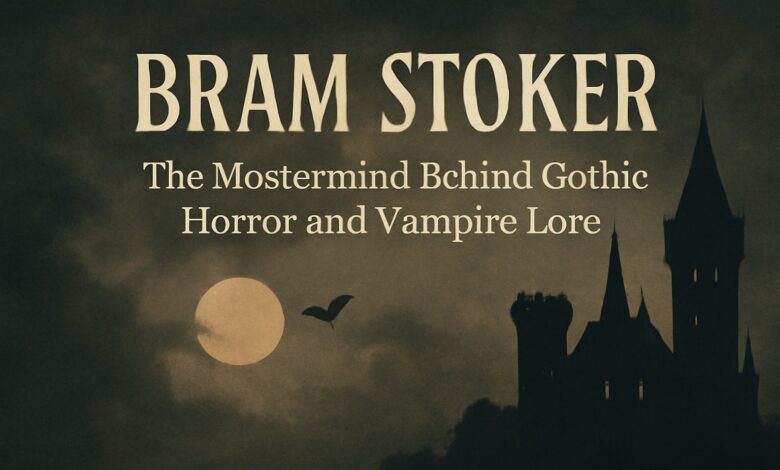Bram Stoker: The Mastermind Behind Gothic Horror and Vampire Lore
Exploring the Life, Works, and Influence of the Legendary Author of Dracula

Introduction
Bram Stoker, a name that reverberates through the annals of literary history, is widely recognized for creating one of the most iconic characters in literature — Count Dracula. His 1897 Gothic novel Dracula remains a cornerstone of vampire lore and horror fiction. But who was Bram Stoker, and how did he contribute to shaping the vampire mythos? In this article, we will dive into the life of Bram Stoker, his books, and the lasting influence of his most famous work on modern horror and popular culture.
The Life of Bram Stoker
Early Life and Education
Bram Stoker was born on November 8, 1847, in Clontarf, Ireland. From a young age, Stoker faced many health challenges, including being bedridden for much of his early childhood. However, his mother, who had been raised on stories of Irish folklore, filled his formative years with tales of the supernatural. These stories would later influence his writing, particularly his creation of Dracula.
Stoker attended Trinity College Dublin, where he excelled in his studies, particularly in mathematics. After graduating, he worked as a civil servant and simultaneously honed his literary skills. During this period, Stoker became known for his interest in theater and began writing for the Dublin Evening Mail as a drama critic.
Stoker’s Professional Life and Connections
In 1878, Stoker’s life took a dramatic turn when he became the personal assistant to the famous actor Sir Henry Irving, eventually managing the Lyceum Theatre in London. This connection to the theater world influenced many of his works, and his relationship with Irving provided him with the exposure to explore dramatic storytelling and deep character development.
Stoker’s personal life was also shaped by his marriage to Florence Balcombe, who had previously been courted by none other than Oscar Wilde. Stoker and Florence had one son, Irving Noel Thornley Stoker.
Bram Stoker’s Works: A Journey Through Gothic Horror
Dracula: The Masterpiece
No discussion of Bram Stoker would be complete without a deep dive into his most famous work, Dracula. Published in 1897, Dracula is a Gothic horror novel that combines elements of folklore, superstition, and dark romanticism. The novel introduces Count Dracula, a vampire who seeks to expand his reign from Transylvania to England, encountering Jonathan Harker, Mina Harker, Van Helsing, and a cast of unforgettable characters.
The novel is a masterful blend of an epistolary novel (told through letters, journal entries, and newspaper clippings) and chilling horror elements. It brings together vampire mythology, blood, immortality, and dark supernatural themes that would go on to inspire countless adaptations, including Nosferatu, Hammer Horror films, and modern portrayals like Christopher Lee’s Dracula.
Influence of Vampire Lore
Dracula is more than just a story about a vampire; it taps into centuries of vampire mythology and superstitions. Elements like garlic, holy water, stakes through the heart, and shapeshifting are central to the story and have since become standard vampire tropes in popular culture. The novel’s introduction of Nosferatu as a vampire—characterized by its need for blood to survive—set the stage for countless interpretations in modern horror fiction.
Other Notable Works by Bram Stoker
Though Dracula is Stoker’s most famous novel, he penned other works that contributed to the Gothic and horror genres:
-
The Primrose Path (1875)
-
The Snake’s Pass (1890)
-
The Jewel of Seven Stars (1903)
-
The Mystery of the Sea (1902)
-
The Lair of the White Worm (1911)
These works explored themes of the supernatural, adventure, and romance, all laced with Stoker’s signature Gothic elements.
The Enduring Legacy of Bram Stoker
Impact on Vampire Mythology
The creation of Count Dracula is arguably one of the most significant contributions to modern vampire mythology. Stoker’s version of the vampire is complex, blending human characteristics with the undead horror of the supernatural. Transylvania, vampire brides, and the castle lair have become synonymous with vampire lore, largely due to Stoker’s vivid descriptions in Dracula.
Influence on Horror Literature
Stoker’s influence extends beyond just the vampire genre. His works, particularly Dracula, played a pivotal role in the development of Gothic fiction and horror literature. The combination of horror, suspense, and the supernatural found in Stoker’s writing inspired authors such as Mary Shelley (author of Frankenstein), H.P. Lovecraft, and countless others who have contributed to the horror genre.
Film Adaptations and Pop Culture
Dracula has seen numerous film adaptations, with notable versions including the 1931 Nosferatu film, Bram Stoker’s Dracula (1992), and many Hammer Horror films. These adaptations have solidified Stoker’s legacy in pop culture, shaping how we view vampires and horror films today. Count Orlok in Nosferatu (1922) and Christopher Lee’s portrayal of Dracula have influenced the look and feel of vampires in modern media.
Frequently Asked Questions (FAQ)
1. Who is Bram Stoker?
Bram Stoker was an Irish author best known for writing the Gothic horror novel Dracula. His works have greatly influenced the vampire genre and horror literature as a whole.
2. What is Bram Stoker’s most famous book?
Stoker’s most famous book is Dracula (1897), a Gothic horror novel that introduced the world to Count Dracula, a vampire from Transylvania.
3. What influence did Bram Stoker have on vampire lore?
Bram Stoker’s Dracula defined modern vampire mythology, incorporating elements such as immortality, blood drinking, vampire brides, and shapeshifting, which are now staples in vampire fiction.
4. Did Bram Stoker write any other notable works?
Yes, Stoker also wrote several other novels, including The Mystery of the Sea (1902), The Jewel of Seven Stars (1903), and The Lair of the White Worm (1911), all of which contain supernatural elements.
5. Why is Dracula so important in horror literature?
Dracula is considered a cornerstone of horror literature because it established the archetype of the vampire in modern culture and laid the groundwork for much of today’s horror fiction.
Conclusion
Bram Stoker’s contribution to Gothic fiction, vampire mythology, and horror literature is undeniable. His creation of Count Dracula has left a lasting legacy, influencing film adaptations, horror novels, and pop culture for generations. Through his unique blend of folklore, dark romanticism, and supernatural horror, Stoker has shaped how we view the undead and immortality, and his impact on the horror genre continues to resonate today.
Whether you are a fan of vampire lore, Gothic fiction, or the legacy of Nosferatu, Bram Stoker’s works remain as relevant and captivating as ever, ensuring his place as a master of Gothic horror for years to come.

